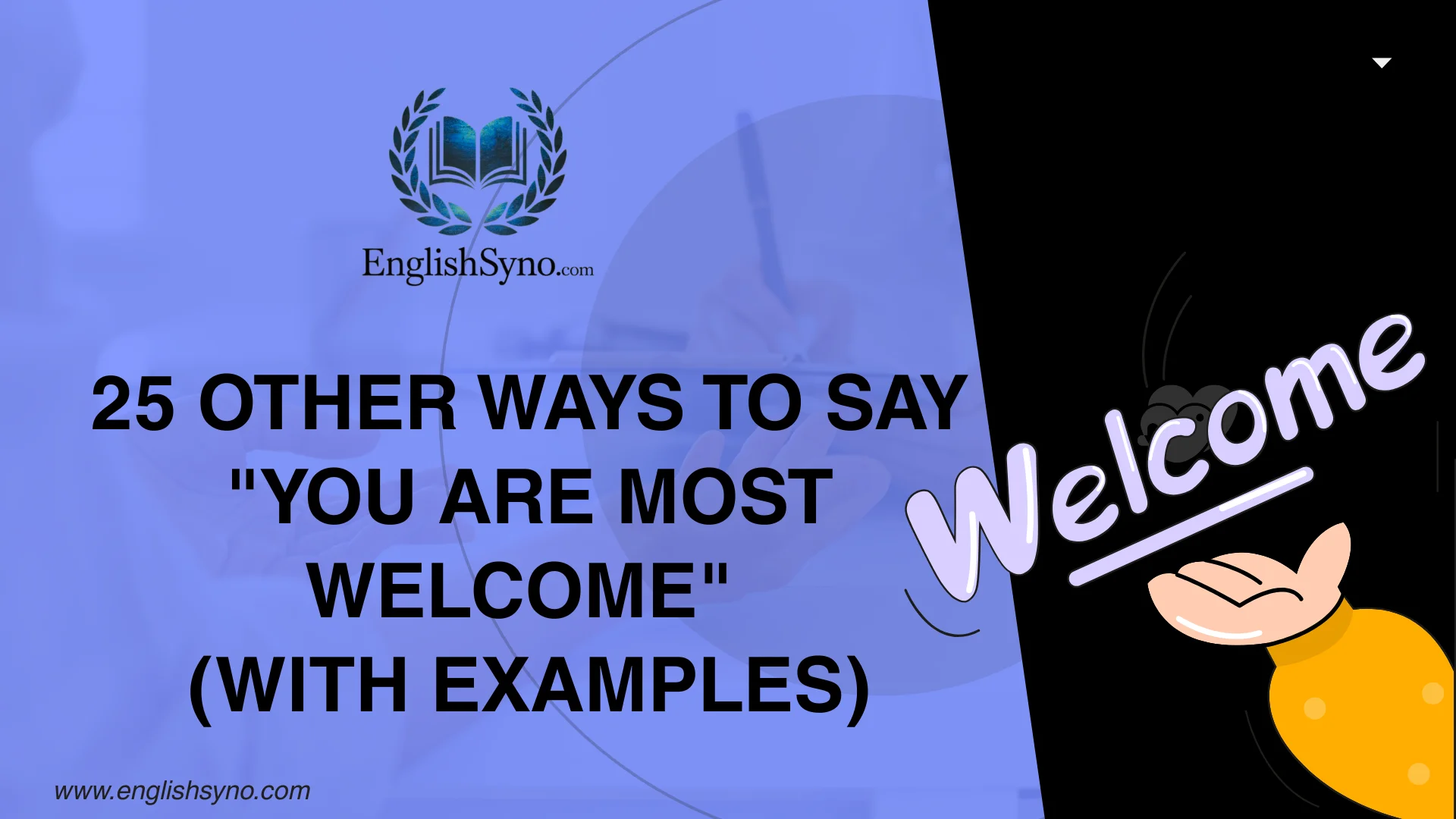When you want to respond naturally, saying “you are most welcome” shows you are approachable and friendly, and it can also signal that you got it when someone thanks you, making interactions feel relaxed and pleasant, whether at home, outside, or with friends.
Keeping your tone reserved but warm helps maintain comfort in casual settings while ensuring your response is polite and appreciated. A relaxed, informal reply like “you got it” works well with friends, outside gatherings, or any moment where a friendly acknowledgment is needed.
What Does “You Are Most Welcome” Mean?
Definition & Meaning: “You are most welcome” is a polite, respectful, and sometimes formal way to respond when someone expresses thanks. It conveys gratitude, acknowledges their appreciation, and reassures them that your help was given willingly.
Detailed Explanation: This phrase emphasizes that your assistance, whether big or small, was freely offered and genuinely appreciated. Using it reinforces positive social interactions and can be adapted for both personal and professional contexts.
When to Use “You Are Most Welcome”
You should use “you are most welcome” when you want to:
- Show politeness
- Acknowledge gratitude formally
- Maintain a professional tone
- Respond in personal interactions where your assistance is recognized
Is It Professional/Polite to Say “You Are Most Welcome”?
Yes, “you are most welcome” is both professional and polite, making it ideal for formal contexts. It avoids any casual tone and reflects manners and social grace.
Pros and Cons
Pros:
- Clearly acknowledges gratitude
- Maintains politeness
- Adaptable to formal and semi-formal situations
- Shows willingness to help
Cons:
- Can sound stiff or overly formal in casual settings
- It may be redundant if used repeatedly with close friends
No Problem
Definition & Meaning: Informal response indicating that helping was not an inconvenience.
Detailed Explanation: Suggests the action was effortless and emphasizes relaxed friendliness.
Example:
- Colleague: “Thanks for covering my shift!”
- You: “No problem!”
Best Use: Informal, casual, friendly environments
Worst Use: Formal or professional emails
Tone: Casual, approachable, friendly
No Worries
Definition & Meaning: Conveys that the action was not troublesome; casual and reassuring.
Detailed Explanation: Popular in conversational English, often used in Australia and informal contexts.
Example:
- Friend: “Thanks for picking me up.”
- You: “No worries!”
Best Use: Friends, casual conversations
Worst Use: Formal business emails
Tone: Relaxed, friendly, reassuring
Anytime
Definition & Meaning: Shows willingness to help at any time; informal and friendly.
Detailed Explanation: Suggests future readiness to assist, emphasizing openness.
Example:
- Friend: “Thanks for your help earlier!”
- You: “Anytime!”
Best Use: Friends, casual settings
Worst Use: Formal or corporate communication
Tone: Friendly, approachable, helpful
My Pleasure
Definition & Meaning: A Formal response indicating you were happy to help.
Detailed Explanation: Highlights satisfaction derived from assisting, more formal than casual alternatives.
Example:
- Client: “Thanks for your advice.”
- You: “My pleasure. I’m glad I could assist.”
Best Use: Professional, formal contexts
Worst Use: Casual or overly familiar settings
Tone: Polite, warm, professional
Happy to Help
Definition & Meaning: Friendly, informal expression showing willingness and satisfaction.
Detailed Explanation: Indicates that assisting was a positive experience for you and reassures the other person.
Example:
- Colleague: “Thanks for guiding me through the report!”
- You: “Happy to help!”
Best Use: Office, casual professional environments
Worst Use: Overly formal emails
Tone: Friendly, supportive, approachable
Certainly
Definition & Meaning: A polite, formal way to acknowledge thanks while affirming willingness to help.
Detailed Explanation: Shows confidence and respect in responding to gratitude; often used in professional or formal settings.
Example:
- Client: “Thank you for clarifying the contract details.”
- You: “Certainly. I’m happy to assist.”
Best Use: Professional meetings, formal communication
Worst Use: Casual conversations with friends
Tone: Formal, respectful, confident
Of Course
Definition & Meaning: Conveys that helping was natural and expected; polite yet friendly.
Detailed Explanation: Implies that assisting required no extra effort and was a natural response.
Example:
- Colleague: “Thanks for lending me your notes.”
- You: “Of course!”
Best Use: Semi-formal or casual professional settings
Worst Use: Overly casual with very close friends might feel redundant
Tone: Polite, friendly, reassuring
Don’t Worry About It
Definition & Meaning: Casual reassurance that the help was not a burden.
Detailed Explanation: Often used to downplay the effort, making the other person feel at ease.
Example:
- Friend: “Thanks for bringing my laptop.”
- You: “Don’t worry about it.”
Best Use: Informal, friendly situations
Worst Use: Formal work emails or corporate messages
Tone: Relaxed, approachable, casual
You Got It
Definition & Meaning: An Informal phrase to indicate that helping was easy and you are available to assist again.
Detailed Explanation: Friendly and casual, best reserved for peers, friends, or informal colleagues.
Example:
- Friend: “Thanks for fixing my bike!”
- You: “You got it!”
Best Use: Friends, casual workplace interactions
Worst Use: Formal professional emails
Tone: Casual, friendly, approachable
No Trouble at All
Definition & Meaning: Expresses that the action was effortless and was done gladly.
Detailed Explanation: Reassures the person that assisting was smooth and welcomed.
Example:
- Neighbor: “Thanks for watering my plants.”
- You: “No trouble at all.”
Best Use: Informal or semi-formal personal interactions
Worst Use: Overly casual for corporate emails
Tone: Friendly, polite, reassuring
It Was Nothing
Definition & Meaning: Humble way to acknowledge thanks, downplaying your effort.
Detailed Explanation: Suggests the action was minor but still appreciated by the recipient.
Example:
- Friend: “Thanks for helping me with homework.”
- You: “It was nothing.”
Best Use: Casual, friendly settings
Worst Use: Formal workplace communication
Tone: Humble, relaxed, informal
Anytime You Need
Definition & Meaning: An Informal phrase showing availability and willingness to assist again.
Detailed Explanation: Emphasizes continued support and openness for future help.
Example:
- Friend: “Thanks for helping me move today.”
- You: “Anytime you need!”
Best Use: Friends, informal peers
Worst Use: Formal correspondence
Tone: Friendly, supportive, casual
It’s My Honor
Definition & Meaning: Formal, respectful acknowledgment emphasizing pride in helping.
Detailed Explanation: Often used in ceremonial or professional contexts to show gratitude for the opportunity to assist.
Example:
- Manager: “Thank you for leading the project.”
- You: “It’s my honor to contribute.”
Best Use: Formal, professional recognition
Worst Use: Casual, everyday conversation
Tone: Respectful, formal, warm
I’m Glad to Help
Definition & Meaning: Friendly expression showing happiness in being of assistance.
Detailed Explanation: Conveys genuine satisfaction in helping, suitable for personal or professional interactions.
Example:
- Colleague: “Thanks for reviewing my report.”
- You: “I’m glad to help.”
Best Use: Office, casual professional settings
Worst Use: Overly formal situations
Tone: Friendly, warm, approachable
Always Happy to Help
Definition & Meaning: Informal phrase showing consistent willingness to assist.
Detailed Explanation: Reinforces your supportive and approachable nature over time.
Example:
- Friend: “Thanks for picking me up last minute.”
- You: “Always happy to help.”
Best Use: Friends, casual work environments
Worst Use: Formal emails
Tone: Friendly, cheerful, supportive
Glad I Could Help
Definition & Meaning: Casual response showing satisfaction from assisting.
Detailed Explanation: Highlights your contribution in a positive, approachable way.
Example:
- Colleague: “Thanks for guiding me with this software.”
- You: “Glad I could help.”
Best Use: Office or peer interactions
Worst Use: Overly formal settings
Tone: Friendly, polite, relaxed
It Was a Pleasure
Definition & Meaning: Formal, polite acknowledgment emphasizing enjoyment in assisting.
Detailed Explanation: Signals that helping was rewarding and appreciated the opportunity.
Example:
- Client: “Thanks for your support today.”
- You: “It was a pleasure assisting you.”
Best Use: Professional or formal settings
Worst Use: Casual texting among friends
Tone: Polite, warm, formal
I’m Always Here to Help
Definition & Meaning: Casual to semi-formal phrase emphasizing ongoing support.
Detailed Explanation: Shows reliability and commitment to helping in the future.
Example:
- Friend: “Thanks for listening today.”
- You: “I’m always here to help.”
Best Use: Semi-formal, informal contexts
Worst Use: Overly stiff in casual chat
Tone: Supportive, reliable, approachable
It’s No Big Deal
Definition & Meaning: Casual, humble way to minimize the effort involved.
Detailed Explanation: Suggests that your assistance is required little effort but is appreciated.
Example:
- Friend: “Thanks for bringing my book back.”
- You: “It’s no big deal.”
Best Use: Informal, friendly settings
Worst Use: Formal or professional emails
Tone: Casual, humble, approachable
Not at All
Definition & Meaning: Polite, formal reassurance that helping was effortless.
Detailed Explanation: Commonly used in professional settings or when responding to formal thanks.
Example:
- Client: “Thank you for your guidance.”
- You: “Not at all. Happy to help.”
Best Use: Formal, professional communication
Worst Use: Casual texting with friends
Tone: Polite, professional, respectful
It’s Okay
Definition & Meaning: Informal reassurance indicating that helping was not a burden.
Detailed Explanation: Softens the response, making the other person feel at ease.
Example:
- Friend: “Thanks for helping me carry groceries.”
- You: “It’s okay.”
Best Use: Casual, friendly environments
Worst Use: Formal or professional contexts
Tone: Relaxed, friendly, approachable
Think Nothing of It
Definition & Meaning: Polite, slightly formal way to downplay your assistance.
Detailed Explanation: Suggests your help was effortless and does not require acknowledgment.
Example:
- Neighbor: “Thank you for shoveling my driveway.”
- You: “Think nothing of it.”
Best Use: Semi-formal, polite social interactions
Worst Use: Too formal for casual texting
Tone: Polite, humble, respectful
It Was the Least I Could Do
Definition & Meaning: A Formal or semi-formal expression emphasizing humility in helping.
Detailed Explanation: Shows that you did what you could and emphasizes modesty.
Example:
- Colleague: “Thanks for taking care of the report.”
- You: “It was the least I could do.”
Best Use: Professional, formal social settings
Worst Use: Casual conversation with friends
Tone: Humble, polite, formal
I’m Here for You
Definition & Meaning: Casual, friendly expression showing availability and support.
Detailed Explanation: Conveys a sense of companionship and readiness to help whenever needed.
Example:
- Friend: “Thanks for helping me through that situation.”
- You: “I’m here for you.”
Best Use: Friends, informal support
Worst Use: Formal professional emails
Tone: Friendly, supportive, empathetic
Anytime, Happy to Help
Definition & Meaning: An Informal phrase expressing readiness and enjoyment in assisting.
Detailed Explanation: Combines willingness and cheerfulness, making the response feel warm and personal.
Example:
- Friend: “Thanks for covering my shift!”
- You: “Anytime, happy to help!”
Best Use: Informal, friendly, casual professional
Worst Use: Formal corporate emails
Tone: Friendly, cheerful, approachable
Final Thoughts
Mastering the art of responding with “you are most welcome” and its alternatives allows you to communicate warmth, appreciation, and genuine care. Whether in professional, casual, or personal settings, choosing the right phrase can strengthen relationships, convey sincerity, and make gratitude feel meaningful. Words such as “my pleasure”, “no problem”, or “happy to help” allow you to match tone with context, demonstrating social awareness and emotional intelligence.
Understanding the subtle differences between formal and informal alternatives ensures that your response is appropriate for the situation. For instance, “certainly” or “of course” works well in office emails, while “you got it” or “anytime” fits casual conversations with friends. Being mindful of tone, timing, and context shows respect and thoughtfulness, fostering a culture of gratitude and collaboration.
Using these phrases consistently also helps build your personal brand of politeness and reliability. People notice when someone responds with genuine warmth rather than a generic acknowledgment. Additionally, by being confident and relaxed in your delivery, you can make interactions smoother, more human, and emotionally engaging.
Ultimately, the goal is to make the person expressing thanks feel recognized and appreciated. Exploring the 35 alternatives listed above provides versatility and depth in your communication toolkit. By practicing these responses, you can confidently navigate diverse scenarios it in the workplace, home, or social gatherings create a positive impression that resonates long after the conversation ends. Gratitude, when expressed thoughtfully, strengthens bonds, encourages collaboration, and fosters goodwill everywhere you go.
FAQs
What does “you are most welcome” mean?
It is a polite and respectful way to acknowledge thanks, showing that helping was appreciated and willingly given. It works in both formal and informal contexts.
Can I use “you are most welcome” in professional emails?
Yes, it is polite and professional, especially when acknowledging gratitude from colleagues, clients, or supervisors.
Is “my pleasure” the same as “you are most welcome”?
Yes, it is a formal or semi-formal alternative that conveys happiness in helping, often suitable for professional interactions.
When should I use “no problem”?
Use “no problem” in casual or informal settings to indicate that helping was easy and effortless.
Can “you got it” be used at work?
It works with peers in informal professional settings but is not recommended for formal emails or with clients.
What is the best tone for “happy to help”?
Friendly, approachable, and supportive. Ideal for both casual and semi-professional settings.
Is it polite to say “don’t worry about it”?
Yes, in informal situations, it reassures the person that helping was not a burden.
What is the difference between “certainly” and “of course”?
“Certainly” is slightly more formal, while “of course” is polite but friendly, suitable for casual and semi-formal interactions.
Can these alternatives make gratitude feel more personal?
Yes, choosing the right phrase based on context and tone adds warmth and thoughtfulness to your response.
Are there alternatives suitable for friends?
Yes, phrases like “you got it,” “anytime,” and “I’m here for you” are casual, friendly, and approachable.
Is “it was nothing” too casual?
It is humble and informal, ideal for friends or peers, but not recommended in formal professional communications.
How can tone affect the response?
Tone conveys sincerity, warmth, and professionalism. Matching tone to context ensures the message is well-received.
Can using these phrases improve workplace relationships?
Absolutely. Thoughtful responses foster collaboration, trust, and a positive atmosphere.
Is “always happy to help” appropriate for emails?
Yes, in semi-formal or friendly professional emails, it communicates willingness and approachability.
Why is it important to have multiple alternatives?
Multiple alternatives allow you to respond appropriately in different contexts, from casual chats to formal professional settings, making your gratitude more meaningful.



